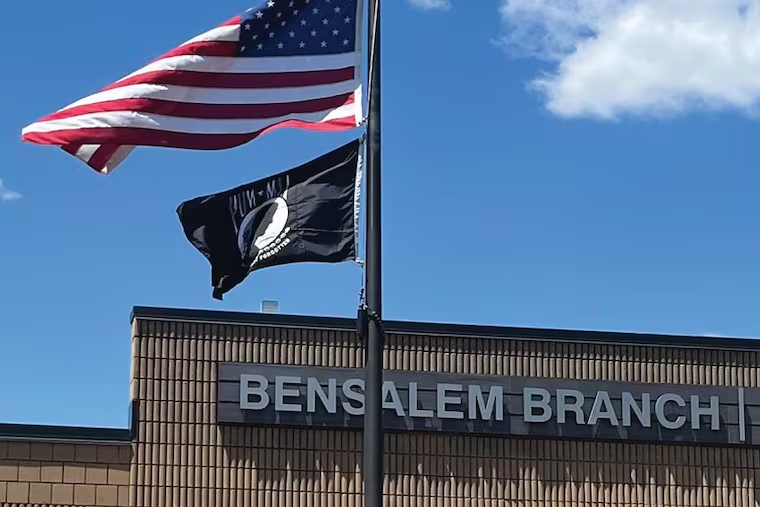This Bucks County veteran is working to get the POW/MIA flag flying wherever the Stars and Stripes are
Alan J. Micklin doesn’t want the 82,000 soldiers still missing and unaccounted for from wars since WWII to be forgotten.

In 2019, President Donald Trump signed the POW/MIA Flag Act requiring the flag, which commemorates Prisoners of War (POW) and those Missing in Action (MIA), to be displayed beneath the American flag at prominent federal properties.
The bipartisan legislation was backed by a long list of supporters, including the National League of POW/MIA Families and Veterans of Foreign Wars.
But its most ardent supporter is probably Alan J. Micklin.
A one-man battle
Micklin, 83, is a Bucks County Vietnam veteran who, since November 2022, has been waging a one-man battle to ensure the flag law is actually implemented.
“The POW/MIA [flag] is us remembering the forgotten. It is a part of history,” Micklin said, dismayed at the seeming lack of interest in veterans who made the ultimate sacrifice. Since WWII, about 82,000 soldiers are categorized as Prisoners of War (POW), Missing in Action (MIA), or otherwise unaccounted for.
A year after the federal law was enacted, the state also passed legislation allowing for the POW/MIA flag to be displayed on Commonwealth grounds or buildings.
Yet, Micklin is concerned that neither law is being followed — dishonoring, he says, the service of those who have never returned home.
“I see it in two ways. I see the flag issue as pushed aside as not important as a priority. And I guess you could say it is disrespectful, especially since we still have so many MIAs existing. Look at the families that just got done with Christmas that have loved ones that are still MIAs and never came back. It’s horrible,” Micklin said.
How his campaign started
Micklin said he didn’t set out to become a national advocate for displaying the POW/MIA flag.
In 1990, Congress designated the POW/MIA flag as our country’s symbol of concern for POWs and MIAs in Southeast Asia. For about the past 20 years, Micklin has displayed the POW/MIA flag along with the American flag on the flagpole at his home.
“I live in Bensalem and I went to the township building. I had some business to do there and I saw the American flag and the state flag and I’m saying to myself, ‘Where is the POW/MIA flag?’”
Raised in South Philadelphia, Micklin entered the Army after graduating from Bartram High School. It’s still too painful for him to talk about his wartime experiences in Vietnam or the scorn that greeted returning Vietnam veterans.
“I don’t talk about it. It’s too hurtful. I lost close friends,” Micklin said.
When he left the service, he attended photography school in California and ultimately became a photojournalist in Philadelphia. He also has volunteered over the years in various veteran-related activities, including feeding veterans and renovating their homes.
But he’s given all that up to bring attention to the POW/MIA flag.
“I’m strictly focused on this now,” he said.
The ups and downs
Micklin is dogged in his efforts and ultimately wants the flag flown wherever the American flag is flown.
Over the past year he said there have been accomplishments — the Boy Scouts of America in Doylestown support the idea as well as the township office and library system in Bensalem. Individual firehouses throughout Bucks County have also agreed to display the flag.
“I called City Hall [in Philadelphia] and someone in administration told me that they absolutely fly the POW/MIA flag under the American flag at City Hall but I haven’t seen it yet.”
He wants to see the flag at all of the city’s federal buildings, including the Robert N.C. Nix Federal Building, the William J. Green Jr. Federal Building, and the United States Mint.
“The POW-MIA (flag) is us remembering the forgotten. It is a part of history.”
The 2023 U.S. General Services Administration’s flag policy states the POW/MIA flag must be displayed along with the American flag at federal buildings that have an office of the Secretary of State, the Secretary of Veterans Affairs, the director of the Selective Service System, or a post office.
In addition, the POW/MIA flag must fly at the White House and U.S. Capitol; the Korean War, Vietnam Veterans, and World War II memorials; national cemeteries, military installations, post offices, and VA medical centers.
Displaying the flag, despite bipartisan support, is not without its detractors.
The flag law Trump signed mandated that it be placed “in a manner designed to ensure visibility to the public,” but a year later the flag was removed without explanation from atop the White House and placed in a less visible location. President Joe Biden, at the urging of a bipartisan group of senators, returned it to its perch in 2021.
“I’m getting resistance and I have no idea why. None whatsoever,” said Micklin, who thinks it’s more about organizations being too overwhelmed with daily responsibilities to make flying the flag a priority.
Flag creation
The National League of Families of American Prisoners and Missing in Southeast Asia was looking for a flag design to promote their organization in 1971. The following year, the POW/MIA flag was created by New Jersey graphic artist Newton F. Heisley for Annin Flagmakers — at the time the world’s largest flag manufacturer.
The black-and-white flag with a silhouette of a man with his head bowed, a guard tower, and a strand of barbed wire and the words “You Are Not Forgotten” grew in popularity, but over the decades it has become less visible.
“This has been a learning experience,” Micklin said. “The reason I say that is I was floored when I would ask people and they don’t even know what the POW/MIA flag is. They have no clue.”